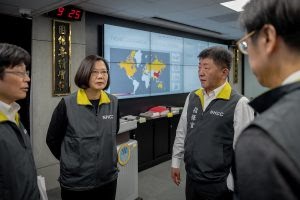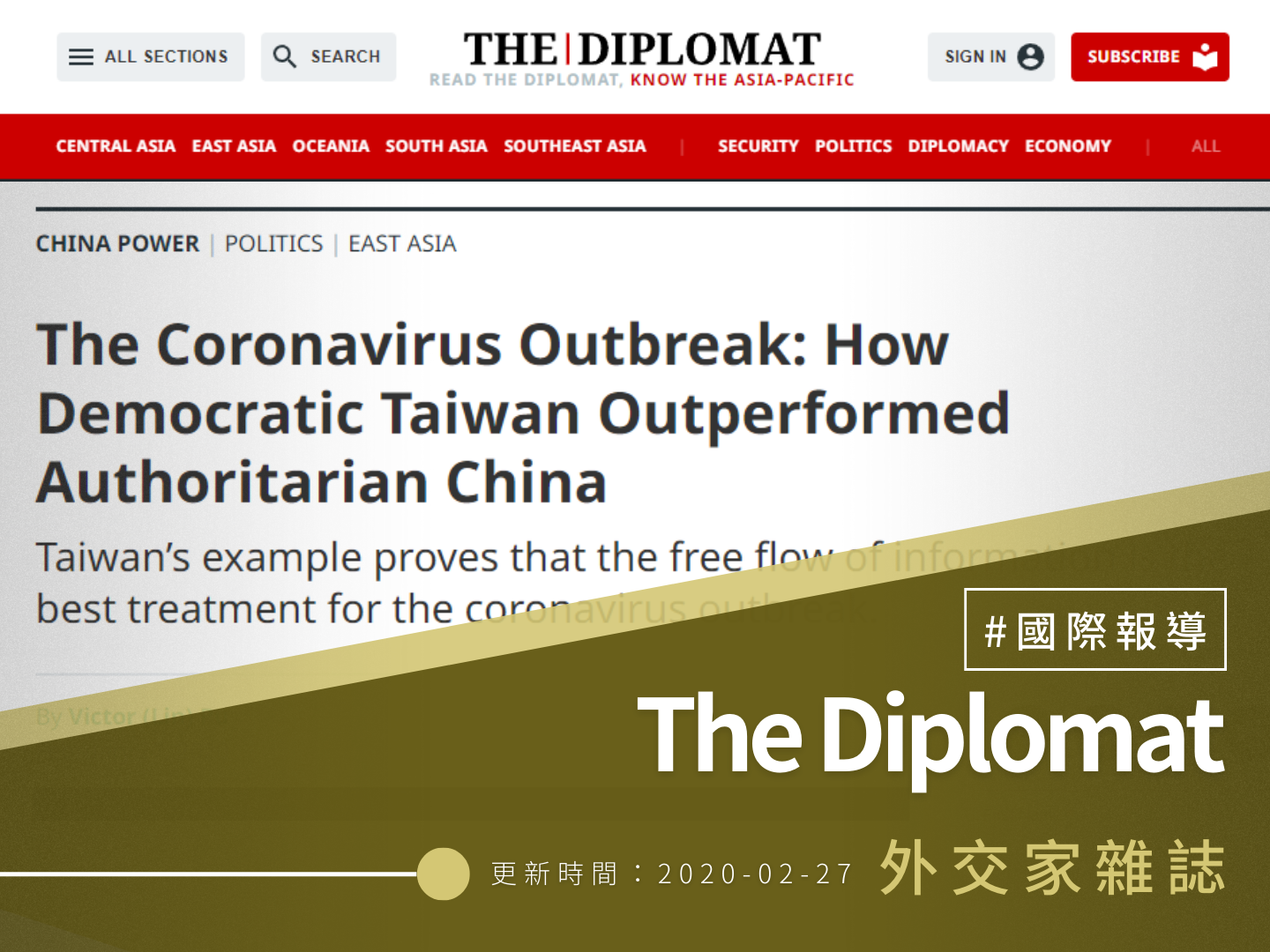【外交家雜誌】The Coronavirus Outbreak: How Democratic Taiwan Outperformed Authoritarian China
【2020年2月27日 《外交家雜誌》CHINA POWER/POLITICS/EAST ASIA】
Taiwan's example proves that the free flow of information is the best treatment for the coronavirus outbreak.
By Victor (Lin) Pu
February 27, 2020

Tsai Ing-wen visits Taiwan's Central Epidemic Command Center for the coronavirus response.
Credit: Flickr/ Office of the President, ROC (Taiwan)
The novel strain of coronavirus (officially dubbed COVID-19) that originated in Wuhan, China has spread to almost 30 countries, including regional neighbors like South Korea, Japan, and Taiwan, and countries as far away as the United States, Canada, and Brazil. As of February 26, more than 81,000 cases have been confirmed worldwide, and the death toll has surpassed 2,700, mostly in China. The epicenter of the virus crisis, China, has been suffering socially and economically not only on account of the virus, but also because of the Chinese government’s problematic policies.
The Chinese government has been working to tackle the coronavirus outbreak by using multiple measures to contain the spread of the virus as well as information about the outbreak. Most famously, the government imposed an extreme quarantine in Wuhan on January 23, which is still in place over a month later. Many cities in Hubei province and elsewhere in China have also implemented lockdowns or restrictions while cases of infection continue to increase.
Besides these measures in the physical world, the Chinese government has attempted to quarantine discussion of the epidemic in the realm of public opinion. From the first appearance of the new virus last December to the lockdown of massive cities in mid-January, the Chinese authorities chose to restrict public access to the information about the epidemic by silencing people, most famously the whistleblower Doctor Li Wenliang. In the early stages of the outbreak, the Chinese government issued a statement asserting that “the disease is preventable and controllable,” and announcements sent by Chinese officials to World Health Organization (WHO) office in Beijing claimed that there was no evidence of the disease being transmitted between humans.
But the Chinese scientists writing in The Lancet medical journal later revealed that the first patient known to have contracted the novel coronavirus had no link to the Wuhan seafood market that the Chinese government pointed to as the source of the outbreak. This would suggest that the virus all along was spreading via human-to-human transmission – and that the government was lying to the public from the very beginning of this catastrophe.
Chinese news outlet Caixin covered the story of Dr. Li Wenliang, who became famous after being detained for posting about the new virus online. Li later died of the coronavirus himself, inspiring rare public anger against China’s censorship system. “There should be more than one voice in a healthy society,” Li told Caixin. When his death was reported, Chinese social media platforms were flooded with netizens’ anger and calls for freedom of speech. It seemed for a moment that the Chinese media and civil society had won more space for free speech, granted by the Chinese government as a safety valve for the pressure building from the bottom up.
But in fact, the central government began tightening its media and online controls soon, after a short period of tolerance. In February 2020, two Chinese citizen journalists disappeared after continuously reporting stories about the outbreak and posted them online. The Chinese government then expelled three Wall Street Journal reporters, taking advantage of accusations of racism over an editorial headline. In the meantime, China’s top cyber regulator required online technology companies to “create a good online atmosphere” for fighting the virus, and many social media apps and accounts were removed because of their posts of so-called harmful content. The Chinese propaganda department guided the domestic media to cover only positive stories on the coronavirus crisis relief work being done by Chinese authorities. The central government even dispatched journalists to the center of outbreak to accomplish this mission.
Whether China is stepping up propaganda or strengthening media and cyber controls, its primary goal is to maintain regime stability and social control, not to contain the virus outbreak.
On the contrary, Taiwan, a country that has been excluded from the WHO for decades thanks to China’s political pressure, has demonstrated that the better way to contain the coronavirus is not to quarantine news about epidemic, but to make it easier and more convenient for people to access relevant information.
Even though Taiwan has not been kept officially informed by the WHO about the epidemic, the Taiwanese government promptly undertook measures to prevent the spread of the virus in Taiwan in late December last year, and organized the Central Epidemic Command Center (CECC) in January 2020. Since the set-up of the CECC, it has been holding a press conference almost every day to announce the latest policy and information on the epidemic, and to clarify rumors that are circulating on social media. The Taiwanese government also uses digital tools to communicate with the public amid the virus outbreak. For example, Taiwan’s Ministry of Health and Welfare and many Taiwanese politicians of the ruling Democratic Progressive Party (DPP) have used their official social media accounts on outlets like Facebook, LINE, and YouTube to keep the public well informed on everything from the number of available face masks to the updated policy.
Taiwan’s active civil society also plays a critical role in this crisis. To save people time in looking for stores selling face masks, a Taiwanese software engineer built an online real-time map that can show where masks are stocked in convenience stores and drugstores across the island. Following this idea, Digital Minister Audrey Tang, a coordinator between the government and private sector, rapidly developed a better version of the information platform with government data.
Another case of civic participation is the engagement of Taiwanese fact-check institutions and groups, including Taiwan FactCheck Center (TFC) and MyGoPen. They make an effort to fact-check and correct disinformation or misinformation on the epidemic, which mostly circulates online, meanwhile disseminating the right information to the public as third-party independent institutions.
Armed with transparent and sufficient information on the coronavirus epidemic, Taiwanese people actively follow the government’s policies and take actions to curb the spread of virus individually by washing hands and wearing masks. Therefore, even though the self-ruled island is very close to China, the number of infection cases in Taiwan is still low (32 cases, as of February 26) compared to neighboring countries like South Korea (1,261 cases) and Japan (885 cases). Even though the community spread of the virus in Taiwan is looming and seems inevitable, the Taiwanese government and people have shown that they are determined to work together to fight against COVID-19.
However, these contrasting situations between China and Taiwan have not only resulted from their different governance methods. Most importantly, the disparity is because of the totally contrary political logic found in a democracy versus an authoritarian state.
To authoritarian ruler, the first and primary goal of governance is maintaining regime stability and survival to ensure their predominance. When social protest or rebellion happens, the common reaction is to surveil and suppress the dissidents. However, when it comes to natural disasters like earthquakes or floods, the authoritarian government also provides disaster relief, similar to a democratic government. Autocratic leaders can rapidly mobilize national resources into disaster relief works, as seen in the Chinese government’s immediate response to the 2008 Sichuan earthquake, with massive medical teams and troops gathered within one day. But this type of mobilization might not work for curbing an epidemic.
The critical factors for tracking and controlling the spread of a virus are time and information. To collect information about the infectious patients’ location and their TOCC (travel, occupation, contact, and cluster) requires rapid reports from individuals, hospitals, and local governments to the central command center. This helps the government control the epidemic and take responsive policies as quickly as possible. In other words, controlling the spread of a virus requires the free flow of information and public information sharing, which runs contrary to an authoritarian regime’s specialty of resource mobilization. Instead, what happens in authoritarian countries tends to follow this pattern: the local government hides the truth from the central government to avoid blame, and the central government also lies to its people to deflect public criticism at the beginning of an outbreak. As a result, measures to control the disease are delayed and eventually in vain.
Some might argue that China, as the digital authoritarian powerhouse, has the cutting-edge AI technology and surveillance system to track all its people, not to mention infectious patients. Indeed, these high-tech tools are used to monitor and surveil people in the cities under lockdown. But that does not translate to public knowledge. As the number of infectious cases climbs, China’s government ramped up propaganda, covering pro-government and pro-Chinese Communist Party stories, rather than communicating with the public. Due to the lack of transparency and accountability, the authoritarian regime’s propaganda and regulatory departments tend to take actions to censor and control information. And the results prove that this is definitely not the best public health strategy.
To counter and control a viral epidemic, both government and civil society need sufficient information. The characteristics of a democratic society are openness and transparency, which promise the public access to information. On the other hand, a democratic government also has to take responsibility for communicating with people because leaders are accountable to the public. Only when we ensure the free flow of information in a democracy can we construct a healthy society. Besides its strong public health infrastructure, Taiwan proves that the democratic strategy is successful in curbing the spread of the new coronavirus – which is why Taiwan is outperforming its authoritarian neighbor, China.
Victor (Lin) Pu is an analyst currently based in Taipei and a former staffer at the Institute for National Defense and Security Research (INDSR), and National Security Council, Taiwan. He has an M.A. degree in political science from National Taiwan University and focuses on issues related to authoritarian diffusion and Chinese influence.






